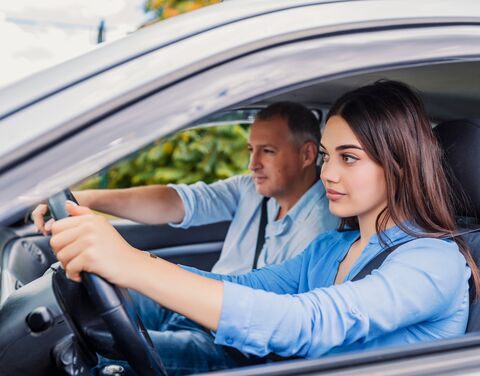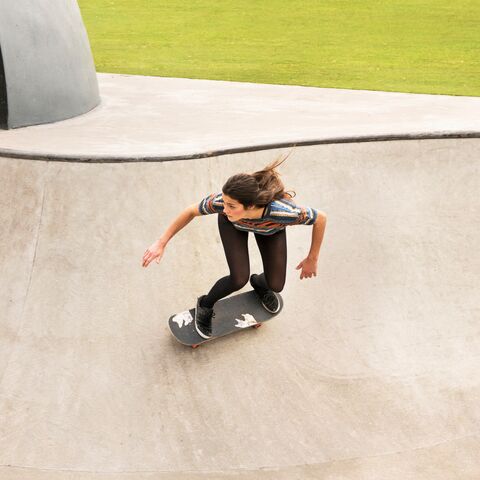
What you need to know about accompanying a learner driver
Seventeen at last! Lots of teenagers can't wait to start driving. Many of them like to practice with a qualified driver as well as taking lessons. It's a great way for them to get used to driving without draining their bank account. But there are a few things that need to be borne in mind – not least having the right insurance.
It takes a lot of time and money to get a driver's license. Driving lessons are the biggest expense: in Switzerland, instructors charge around CHF 90 for a 50-minute lesson. The average learner needs roughly 30, but the Swiss Council for Accident Prevention recommends about 3,000 kilometers or 100 hours of driving practice before applying for a practical test. Many young people simply can't afford to get this much through lessons alone, so they need someone to accompany them on practice drives. The lucky ones have parents, relatives or friends who are happy to offer their free time and the use of their car.
Rules for accompanying a learner driver
In Switzerland, special rules apply to private driving practice. The learner driver, accompanying person, and car must meet the following requirements:
The learner
- is at least 17 years old
- has a valid category B learner's permit
- has not drunk any alcohol whatsoever (0.00% blood alcohol level)
- does not leave Switzerland during driving practice
- only drives on expressways and highways when ready for the test (test appointment booked)
The accompanying person
- is at least 23 years old
- has had a permanent category B driver's license for at least three years
- has not drunk any alcohol whatsoever (0.00% blood alcohol level)
- sits in the passenger seat (apart from at dedicated driver training facilities or for reversing or parking maneuvers)
- only accompanies one person who is not a relative on practice drives per year
The vehicle
- is registered and covered by mandatory third-party liability insurance
- has a handbrake control on the center console that can be reached and operated by the accompanying person at all times
- has a white L on a blue background displayed at the rear during driving practice
How is private driving practice insured?
The person accompanying a learner driver bears a lot of responsibility. He or she must ensure that the learner drives safely and obeys the rules of the road. Any violations could result in a penalty. Luckily, most learners are careful and attentive, so accidents during driving practice are rare. Nevertheless, it helps to clarify the insurance issues beforehand. Here are the most important ones:
Third-party damage
The practice car has mandatory third-party liability insurance if it has a valid license plate. Motor vehicle liability insurance covers damage caused to third parties and/or their property by the insured vehicle, regardless of who's driving it at the time of the accident. The driver must of course have a valid driver's license or learner's permit and permission to drive the car.
Damage to the practice car
If the learner causes an accident with another car, the insurance coverage is the same as it would be with the owner driving. However, drivers under 25 have a higher deductible. The learner must agree with the owner who will pay the costs. These depend on the type of car insurance:
- Comprehensive accidental damage insurance: Newer cars often have comprehensive insurance, and leased cars always do. It covers damage caused by collisions in which the driver is at fault. The best comprehensive insurance includes bonus protection. Without bonus protection, the owner will end up paying a higher premium in the years following an accident in addition to the contractually agreed deductible.
- Partial accidental damage insurance: Comprehensive insurance premiums are relatively expensive, so they don't really make sense for older cars, which often only have partial accidental damage coverage. This means that damage caused by collisions in which the driver is at fault isn't covered, so the owner must bear the full cost of repairs.
Is it worth taking out insurance for third-party drivers?
If the practice car belongs to someone outside the learner's household, third-party driver's insurance is recommended. It covers all costs arising for the owner of the car if the learner has an accident: deductible and loss of bonus in the case of comprehensive accidental damage insurance or full repair cost in the case of partial accidental damage insurance. A loss of bonus under liability insurance is also covered. "Use of private third-party vehicles" is an optional component of personal liability insurance. Learners should check whether it's included in their policy or their parents' policy. Please note that many insurers set limits on how often the third-party vehicle may be used. This information can be found in their terms and conditions. AXA imposes no such limits.
Are young drivers automatically insured?
Young people who are still in full-time education and living with their parents are automatically covered by their parents' insurance. Most insurers require drivers to have their own personal liability insurance as soon as they enter full-time employment or reach the age of 25. AXA continues to cover young drivers as long as they live with their parents and are named in the policy.
Private driving practice:
seven safety tips
Besides the legal requirements, there are a few important tips for practicing safely:
- Only calm people who are in good health and have had enough sleep belong behind the wheel.
- Flat-soled, comfortable shoes that fit well are best for driving.
- The seat, headrest, rear-view mirrors, and side mirrors should always be adjusted to the correct position before setting off, and a second rear-view mirror should ideally be fitted on the passenger side for the accompanying person.
- Beginners should practice in a large space away from the road or on very quiet side roads until they're used to driving the car.
- After this, practice routes should be planned in line with the learner's level of ability.
- Additional challenges such as heavy traffic, difficult road conditions, and poor visibility should also be borne in mind.
- Extra passengers should only be carried on the back seat if the learner is confident and not easily distracted while driving.






